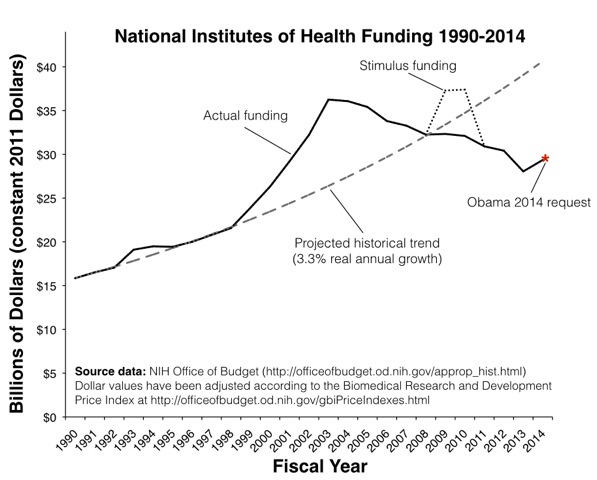Did the period from early November through early January comprise the most remarkable advances in the history of federal mental health policy? It’s a defensible argument. To learn why, check out my latest post at Stanford School of Medicine’s SCOPE blog.
Getting Physicians to Screen for Problem Drinking
One of CDC Director Tom Freiden’s major priorities is increase the number of doctors who screen their patients for risky drinking.
Is it possible? What are the barriers? Find out from my latest post at Stanford School of Medicine’s SCOPE Blog.
WaPo Story on Medicare Hospice Benefit
WaPo had a story on Dec 27, 2013 with a nearly irresistible click bait headline “Hospice firms draining billions from Medicare.” Like much health policy that focuses on the end-of-life, the story raises some valid points, but gives in to the sensational and turns away from the far more difficult reality of the counterfactual: current hospice policy as compared to what?
Medicare policy is inextricably end-of-life policy due to the fact that more than 80% of the people who die each year in the United States are insured by the Medicare program. That is because Medicare insures virtually all persons age 65 and older, and everyone eventually dies.What care should the elderly receive? Does care increase life span? Does it improve quality of life? How much does it cost? Who should decide if the intersection of these questions are worth it? These are very difficult questions to answer. Our country cannot even bear to ask them. So, we look for examples of malfeasance being the problem, in large part because as long as we focus there we don’t have to stare at that set of questions above and imagine our mother, wife, brother or ourselves being the one about whom the questions are posed. Continue Reading…
You want health insurance with terrible customer service? Forget Obamacare-try Blue Cross Blue Shield of Illinois
There’s not much more to my post than the headline: I’ve just concluded my sixth phone call with BCBS of Illinois (having been hung up on the first five times by an automated phone tree which sends you directly to an automated service-satisfaction survey without first giving you any service to be satisfied about). This means I spent the better-or worse-part of two hours trying to find out why BCBS sent me a bill for my January premium I’d already paid on-line.
I went straight to Blue Cross to buy health insurance because I don’t qualify for a subsidy and didn’t see any reason to grapple with-or burden-healthcare.gov. But every time you hear that payments made on the government Website might not be transferring properly to the insurers, please remember that payments made on the Blue Cross Website suffer from the same disability. And while there’s a live chat on Healthcare.gov which at least connects you to a person who can explain the problem, Blue Cross has made sure to keep its product completely untouched by human hands. I finally got through by calling corporate headquarters and explaining first to the corporate operator and then to local customer service and then finally to national customer service (after local stayed on the line with me for ten minutes to assure that national actually picked up) that a bill dated 12/12 should have included an electronic payment made on 12/2, and that no, the bill and my payment hadn’t “crossed in the mail.” In the words of the great Eric Clapton, “How many times must I explain myself ‘fore I can talk to the boss?” though by “Forever Man” I doubt he meant “man with whom you have to stay on hold forever.”
In short (I know, other people’s customer service nightmares are a bore while one’s own is fascinating), everyone who complains about the f***-ups of Obamacare ought to take a second a remember the last time s/he had to deal with a private insurer. In fact, the worst thing about the Affordable Care Act is that it leaves the insurance companies in the picture, and us to their continued tender mercies.
Eating the Seed Corn in the Health Research World
Michael White’s essay on the dismal state of the National Institutes of Health is a must-read for anyone who cares about progress in medical and public health research. The positive impact of the 1998 bipartisan initiative in Congress to double the NIH budget has been completely wiped out.
Of all the bad news in White’s article, this is particular discouraging:
The tighter competition for funding has put the squeeze on younger scientists with fledgling labs; the proportion of young scientists with NIH grants is half of what was in 1998, while the proportion of funded scientists over 65 has doubled. Because scientific training typically takes over 10 years, students who decided to enter graduate school in the boom days of the mid-Aughts are now entering a job market that looks nothing like what they expected.
On the ground in my daily work in both a university medical school and a public hospital, it’s a rare month that some bright young person doesn’t tell me they are quitting science because it’s too hard to get funded. These are usually not reversible decisions. Even a well-trained young physician who leaves research for 5 years to treat patients full-time is very hard to tempt back into science if the funding picture improves (and is even harder to bring back up to speed on the cutting-edge scientific questions and methods of the day).
There is no question that we have some enormously talented and productive senior citizen scientists. But a decade or two from now, when an antibiotic resistant bacteria or new strain of bird flu is ravaging the planet, that generation will no longer be around to lead the scientific charge on humanity’s behalf. That’s why we constantly need a new stream of young people committing to health science careers. That seed corn is currently being consumed at an alarming rate, and if we don’t act immediately to rectify the situation we will suffer for many years to come from the loss of a generation of health researchers.
Antibiotic resistance
1. Yes, we should ban the routine use of antibiotics in farm animals.
2. And yes, the federal government should offer prizes for developing new antibiotics.
But I don’t believe for a second that there are no new antibiotics, or classes of antibiotics, left to discover.
Footnote I’d love to hear a libertarian analysis of the problem of factory farms breeding antibiotic-resistance disease organisms. Sounds like a case for regulation to me. But then I’m just a liberal.
A Forum on Mental Illness, Public Health and Public Safety
The horrifying mass murders at the Washington Navy Yard and Sandy Hook Elementary School were both committed by individuals with long-standing mental-health problems. The events galvanized a national discussion about how to improve the accessibility and quality of our mental-health system.
At the same time, these tragedies can paint in the mind of the public a false image of the mentally ill as universally violent and dangerous rather than human beings in need of assistance and compassionate care. That may account for why a shamefully large number of mentally ill people are behind bars. L.A. County Sheriff Lee Baca has found himself heading what he calls “the nation’s largest mental hospital:” The L.A. County Jail.
While protecting public safety is a critical concern, it’s important to maintain perspective when analyzing the role of mental illness in violent crime. Harold Pollack, PhD, of the University of Chicago puts it this way:
Millions of Americans suffer from some form of severe mental illness, or SMI. It’s important to remember that the vast majority of these men and women have never committed a violent crime and never will commit one. Indeed, the mentally ill are often victims of violent crime, a social problem that has not received sufficient attention.
To dig into these important issues in a productive way, Stanford medical school held a Health Policy Forum devoted to the topic “Serious Mental Illness: How can we promote public health and public safety?” Harold Pollack and Lee Baca graciously came to Stanford for the forum and were joined by Laura Roberts, MD, Chairman of the Department of Psychiatry and Behavioral Sciences and a national expert in serious mental illness.
The FDA’s Mixed Signals on Pain Pill Policy
Prescription opioids like hydrocodone are remarkably useful for acute pain relief but are also capable of fomenting addiction and overdose. The most effective public policies regarding these medications keeps both of those realities in mind rather than yielding to an extreme anti- or pro-opioid stance. No federal government agency grapples with this challenge more than the Food and Drug Administration, and the evidence of the last week is that it has yet to come to an internal consensus on how to proceed.
First, the FDA recommended after years of study that hydrocodone combination products like Vicodin would be moved from Schedule III to the more restrictive Schedule II. This is a significant tightening of control over the most widely prescribed drugs in the U.S. (not just for pain, for anything). The impetus was the leading role of hydrocodone combination products in overdose deaths and emergency room admissions.
Yet 24 hours later, the FDA overruled its own expert panel and approved Zohydro, a pure hydrocodone pain medication that is 5 to 10 times more potent than Vicodin. In the process, FDA also overturned a precedent it had set only six months ago to not approve easily abused-opioids. After refusing in April to approve generic oxycontin because it lacked abuse-resistant properties, the FDA approved a drug whose full potency can be instantly released merely by crushing it or dropping it into alcohol (Get ready for a rash of Zohydro-cocktail deaths).
What the country needs on prescription opioids is carefully designed, balanced and consistent policy. What we are getting is policy that contradicts itself month-to-month and even day-to-day.
Normal Barbies
A footnote to Lowry Heussler´s post on anorexic fashion models. The Daily Mail of all places has a little gallery of images from an experiment by graphic artist Nikolay Lamm. He made a Barbie with the observed average proportions of 19-year old (presumably American) girls:

To me - and I have no reason to think my tastes in the matter are outliers - the normal Barbie is considerably more attractive. Would you, straight male reader, prefer the anorexic official Barbie, with her stringy arms and thighs, giraffe neck, and reproductively dangerous pelvis?
That doesn´t matter, unlike the possible effect on the younger girls who play with Barbies.
Lamm asks a very good question:
People argue that a toy can’t do any harm.
However, if we criticise skinny models, we should at least be open to the possibility that Barbie may negatively influence young girls as well.
Furthermore, a realistically proportioned Barbie actually looks pretty good in the pictures I produced.
So, if there’s even a small chance of Barbie in its present form negatively influencing girls, and if Barbie looks good as an average sized woman in America. What’s stopping Mattel from making one?
Excuse me, but your model needs to be hospitalized.
So I have to go to a cocktail party. I’d rather be beaten with sticks, but it’s not an option. My wardrobe choices are limited; I’m either dressing to work in the yard or go to court. So I browsed through some department store websites, just to see what was out there. Good grief, what a shock.
Isn’t anorexia understood to be a problem? I thought advertisers had agreed to be more responsible and not use models that encouraged teenagers to think their bones should protrude through the skin. Look at this poor thing! Click to enlarge, and check her elbows in case you missed it.
I’ve represented women who looked like this; they were usually charged with prostitution and possession of heroin or cocaine. I always offered to take them to the hospital. Like, before they died in the elevator.
The picture below was taken in 2006. This is backstage at an actual runway event- the model being made up died soon afterward. I assume she wasn’t modeling the underwear, but even if she was about to put on an overcoat, the people in charge should have been shot for allowing her to work.
If the art directors at Bloomingdale’s think there’s nothing wrong with the girl in the pink dress, I’ve got to shop somewhere else. Does LL Bean make cocktail dresses?


